In the second instalment in a series of articles that look at job roles and their relationship with technology, Alana Foster speaks with three unmanned aerial vehicle (UAV) operators.
Drones, or unmanned aerial vehicles (UAVs), having once been the preserve of the military and then hobbyists, are now an established part of many film, TV and commercial shoots, providing shots and perspectives that might otherwise have been out of reach both practically and financially.
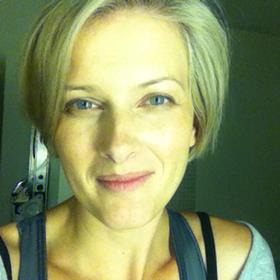
Emma Boswell, Co-Founder, The Helicopter Girls
Drone aerial services provider The Helicopter Girls was conceived in 2010 after freelance producer Boswell and her colleague Kat Nelhams-Wright worked together on a film in Greece and found they were unable to achieve the right perspective without a remote controlled aerial vehicle. The Helicopter Girls’ credits include Mission Impossible: Rogue Nation, Da Vinci’s Demons (Fox) and comedy Detectorists and Mary Berry’s Country House Secrets (both BBC).
What is a typical day in the office?
When we are in the office we test the functionality of the equipment and always have research and development on the go. Maintaining all the aircraft is a priority, and as with any technical business there are often improvements to make to systems and new kit and gizmos to make things more efficient.
Also, we look after the production side of things, liaising with production teams, DOPs and producers. A lot of planning is required for working in congested air spaces, from technical strategies through to flight clearance. Every job we do, part of the risk assessment is looking at the air space you’re required to fly in. We recently worked on a project in the Isle of Dogs in London, which is controlled air space. We needed flight clearance in a restricted zone and getting permission from the Diplomatic Protection Group.
What key technologies are in your kit?
Our base kit consists of a Freefly Alta aircraft and a Freefly gimbal, which are extremely reliable and trustworthy and offer the most sophisticated flight control.
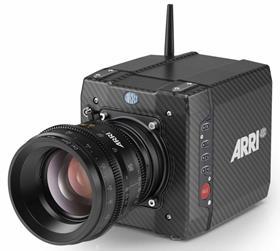
When Arri made the Alexa Mini camera, it changed everything and completely revolutionised the way we work. From a director of photography’s (DOP) perspective they would usually favour the Alexa Mini because it was designed for drones and gimbals and we could get a great camera in the air.
DOPs are always asking us for better quality lenses and higher strength motors that won’t impact the flying time. One of the requests we are often faced with is DOPs wanting us to fly anamorphic lenses, which is quite a big deal. We are flying very sophisticated kit in the air so plenty of planning and preparation for all elements of the operational shot is required.
At the moment we are working on building a moving light source on the drone. We expect this to really change the opportunities for productions.
How has technology changed the way you work?
The manufacturers are building on the demand for this kit and making great components for us to use. The rate of change has made our set-up time faster and reduced the more tedious elements. We ensure we have the latest technological innovation to make sure we are ahead of the curve.
Equipment from Ignite Digi, an Australian aerial cinematography manufacturer, has helped us to stretch our shooting capabilities. They produced a tilt offset which enabled us to fly longer lenses. It was a small advance which has made a huge difference to the way we work.
What is the most challenging aspect of your work?
It is important that technology doesn’t get in the way of creativity; all technology is there to enable us to be creative. The challenge is to make sure the technology is enabling creativity rather than the other way around. From the beginning we decided we would build the air crafts ourselves which was important to make the technical decisions and have flexibility .
We have to be able to work with productions in different ways; sometimes you’ll be with the A unit and other times working in the background, so we have to be flexible.
Helping a DOP to achieve the shots they have in their mind is one of the most challenging but also rewarding aspects.
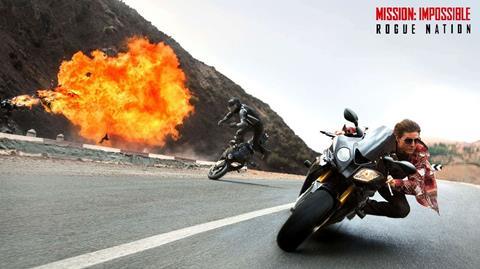
What trends and technology do you expect to change the industry in the next five years?
At the moment technology has reached a point where creatively we are not restricted by anything. Our aircrafts can carry the weight required and we have the flexibility to push the boundaries for our clients.
The evolution of drone technology will feature lights, it is definitely something to watch with more and more productions interested in the possibilities of a moving light source.
We are currently testing the ways we can incorporate infrared technology into our workflows, it’s a more left-of-field scope but the demand is coming from music videos and theatrical productions.
What advice would you give someone aspiring to work with UAVs?
If you’re excited by the concept of creating aerials shots and developing creative ideas for clients then this is the right job for you. Being passionate is just as important as being interested to develop skills and knowledge within the camera department.
You need to possess both creative and operational skills on set. Coming from a remote control background is a quick side step to becoming a drone pilot but I find it fundamental to understand the rounded creative skills to get the perfect shot and effectively communicate within the team is equally as vital.

Jon Hurndall, Co-Founder and Chief Executive, Batcam
Jon Hurndall started his career in Television production in 2004. In 2013, he co-founded BATCAM with fellow TV editor, Alastair Soutar with the aim to provide unique aerial content for broadcast, from live sports broadcasting, feature films, commercials and corporate videos.
What is a typical day in the office?
We spend a lot of time planning before a shoot. There is a significant amount of responsibility in preparing for jobs and making sure the kit is ready for the next event. We have to plan the logistics of all the equipment, hotels, and the team making up the crew and general kit maintenance is fundamental.
On location, the scale of the production will dictate the crew size but as a minimum we will always have a team made up of at least three people including a pilot, camera operator and RF (radio-frequency) engineer.
For a sporting event, usually we will be on location four hours before kick-off. The RF engineer will be installing all antennas and receivers to pick up the video signal, with the pilot and camera operator ensuring the equipment is ready to go for operation ahead of our first test flight for a facilities check with production.
What key technology do you use? Has this evolved since starting Batcam?
Working in live broadcasting we don’t have the luxury of post-production; we must be spot on as we only have one chance. The camera gimbal technology has meant the stabilisation from the shots has improved significantly. When we first started the camera gimbal was driven by pulleys and servos. The introduction and adoption of brushless motors has meant the stabilisation of the camera is excellent whilst being very light and also cost effective. The way we have worked has evolved through plenty of testing and streamlining throughout our five years of developing our standards and practices.
The flight controllers are more sophisticated, and reliable. There have been many small changes across many elements. Propellers were wooden and are now carbon fibre, the difference being the weight and durability. All in all lots of small changes make a difference to the whole system collectively. We are on a constant evolution in making all elements of the system lighter. Lighter is better! Increasing our flight times and reducing strain on the motors and airframes.
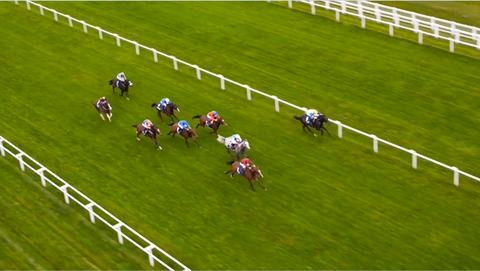
What is the most challenging aspect of your work?
From a technology perspective, our business is split into two sectors: UAVs and broadcast equipment. Both these sectors are evolving extremely fast which is a challenge for our team to track the changes. You have to have a love of both aspects to maintain your knowledge and keep up to date with what is around the corner. This is a positive challenge for us to ensure we are always working at our best. Our clients also make fundamental shifts from time to time, with Sky and BT moving toward live UHD broadcasts recently. Obviously with weight, size and stabilisation to deal with it’s not a simple cross over to just buy a 4K camera. There are many elements to making the technology work to integrate into our Batcam system. That said, we are up to the challenge.

Are there considerations you have to factor into the business operations?
As a commercial drone operator we work with the Civil Aviation Authority (CAA) to get our licence to fly legally in the UK. Five years ago, when we started out there wasn’t a template to working within congested areas and it was taking between two and three weeks to get the licence through from the CAA per job. This kind of time frame became impossible to work within our tight TV timeframes. As a result we worked closer with the CAA to draw up a specific plan based on criteria and get a yearly licence which we now operate under.
The planning of each job and finding a suitable operating area all stems from the safety case of the system.
What trend and technology do you expect to change the industry in the next five years?
The increase of power sources will change the way we work and will be a big game changer for the industry. It will allow more opportunities to bring aerial filming to different sports across different avenues.
Aircraft regulation is slowly changing and is set to impact the way we work and the extent we can deliver aerials shots. If one of the major aircraft manufacturers decided to the expand into the UAV market then, who knows, we may be able to fly over people in congested areas in the future.
Battery technology is something that hasn’t evolved all too much in five years. Our current work flow will alter when we have the capacity to fly for longer. I expect with the longer flight times this will open up other sports and areas of business for us.
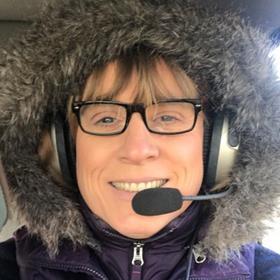
Monica Wyer, Aerial Director of Photography and Operations, Manager Flying TV
Wyer started her career in television in 1993 as a camera trainee in small facilities house in London, working her way up to lighting camera operator across programmes including Grand Designs and Crimewatch. She was passionate about learning to fly and obtained her helicopter pilot licence in 1996. She joined Flying TV as company founder Mike Smith was eager to employ camera operators who were also pilots. Recent credits include aerial footage for BBC drama Silent Witness.
What does a typical day in the office look like for you?
What I love about the business is that a typical day doesn’t really exist. I wear a few different hats, I look after our clients from the first call right though to delivery rushes. What happens in between really depends on the task. Flying TV is one of the few companies that has both helicopters and drones, so we offer the right solution for our clients based on budget and brief.

Helicopter tasks are easier to set up because we don’t have to deal with permissions and film permits anywhere near as often as we do for drone work, even over London. This really surprises people as they naturally expect the opposite. There’s flight planning but far less bureaucracy to deal with. A helicopter task comprises of a crew brief, including where we are going, what we are doing and the system preparation. The GSS Cinema Pro takes a variety of camera and lens combinations, the most popular being the Alexa Mini, then we can kit the ground running.
Drone work brings a lot of variety to the business, for example working with other camera operators. Drone projects are often very straight forward but become more involved once we’re into congested areas or controlled airspace. Much of our drone work comes as a direct result of the helicopter work.
Towards the end of 2017 I shot 4K helicopter aerials for the next three series of Silent Witness. They loved the results so then asked us to work with them on some drone shots for specific story lines.
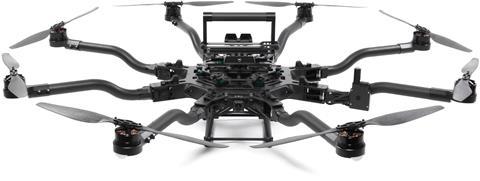
What does your technology kit consist of?
For drone work we fly the Freefly Alta 8 with a MoVi Pro gimbal. It’s a very capable aircraft that will take an Alexa or Red with a fairly hefty lens.
For helicopter work we have a GSS Cinema Pro gimbal that will take most of the current popular camera and lens combination. We fly this on our Robinson R44 helicopters – this is our USP.
How has this technology evolved and changed the way you work?
The drone evolution was something we watched for a few years without getting involved. It wasn’t ready then but once we saw that the capability of aircraft like the Alta 8 and MoVi and could see the results, and it changed everything. It was inevitable that we would invest in it and meet the inevitable demand for this type of production value it offers. Having the flexibility to offer both helicopters and drones and being able to steer clients to the most suitable platform is very useful.
What is the most challenging aspects of working with UAVs?
The weather, because it plays such a big part in what we are able to do with both helicopters and drones. We are at the mercy of good conditions, of course productions always wants the best weather possible. There can be quite a bit of expectation management to be done there - it’s the UK and we have to be realistic.
Aside from that, the very nature of our job is challenging as no two tasks are the same - you’re always going to have something new to deal with. But it’s challenging in a nice way and is a big part of what makes the job fun.
What advice would you give someone aspiring to work in the industry?
Working in the TV industry in general and or with UAVs you have to work hard, be nice and don’t step on toes. After all, it is a small industry and you want to build a strong reputation. Specifically working with drones, you have to pursue it because you love it – it won’t make you a millionaire.
























1 Readers' comment